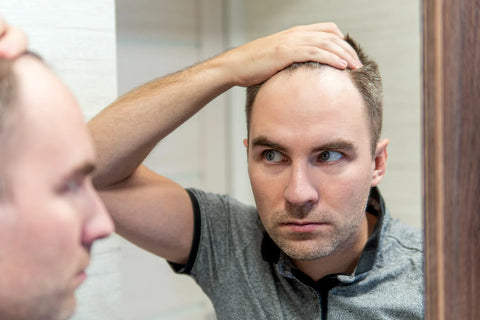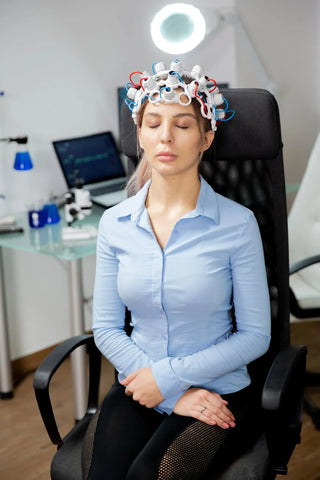Bryan Johnson, a well-known entrepreneur, recently shared his journey of successfully reversing hair loss and greying, drawing significant interest. Having founded Braintree, a prominent payment processing company later acquired by PayPal, and OS Fund, an investment firm focusing on transformative technologies, Johnson's revelation has captured public attention. His openness about addressing common age-related concerns like hair loss and greying offers hope to many facing similar challenges. Johnson's story underscores the potential for breakthroughs in unexpected areas and serves as inspiration for those seeking solutions.

Bryan Johnson's Hair Restoration Journey
Bryan Johnson dove deep into understanding why hair loss and greying occur as people age. He spent a lot of time reading scientific studies and talking to experts who specialize in skin and hair to learn more about what causes these issues. He wanted to get to the root of the problem so he could find effective solutions.
Personal Experiences with Hair Loss and Greying
Bryan Johnson's journey to restore his hair started when he noticed he was losing hair and graying, issues that affect many people as they get older. Even though he was successful in business, these changes affected how he felt about himself. Seeing these changes happen made him want to find ways to fix them.
Motivation Behind Seeking Solutions
Driven by the longing to feel young again and to regain his confidence, Johnson set out to discover ways to restore his hair. His own struggles inspired him to search for new methods and technologies that might help him reverse the effects of hair loss and greying. Recognizing the emotional impact of these changes, Johnson was motivated to find a solution that could not only bring back his hair but also improve his overall happiness and contentment.
Initial Attempts and Challenges
As Johnson delved deeper into his quest for hair restoration, he encountered several hurdles and difficulties. He began by trying out traditional remedies like over-the-counter hair products and topical solutions, hoping they would help reverse his hair loss and greying. Unfortunately, these methods didn't yield the results he hoped for, leaving him feeling disappointed and disheartened. Navigating through the multitude of available options proved to be overwhelming, adding to his frustration. Despite these setbacks, Johnson remained steadfast in his determination to find alternative solutions and explore cutting-edge technologies that held promise in his journey toward hair restoration.
Exploration of Various Treatments and Methods
Bryan Johnson tried many different treatments to help with his hair loss. He looked into everything from old-fashioned remedies to the latest technology. He tried taking supplements, using special creams, and changing his lifestyle to see if anything would work.

Red Light Therapy Cap
Bryan Johnson uses a red light therapy cap with 32 lasers every morning to prevent hair loss. This cap promotes blood flow to the scalp and stimulates hair growth. While research on this treatment is ongoing, Johnson finds the initial results promising and plans to continue using the cap as part of his hair care routine. Red light therapy is believed to improve cellular function and tissue repair by emitting specific wavelengths of light. Although it may not be the most potent solution, Johnson remains committed to exploring innovative approaches for hair restoration. He emphasizes the importance of consistency and patience when trying new treatments, as results may take time to appear.
Customized Topical Formulation
Johnson's powerful hair formulation comprises scientifically proven ingredients to combat hair loss effectively. Minoxidil, a vasodilator, promotes hair growth by widening blood vessels in the scalp. Finasteride blocks the hormone responsible for hair loss, reducing its effects. Ketoconazole, an antifungal agent, may also inhibit the hormone linked to hair loss. Saw palmetto, derived from a palm plant, may block the enzyme that converts testosterone to dihydrotestosterone, a hormone implicated in hair loss. Additionally, rosemary oil stimulates blood circulation to the scalp, promoting hair growth. These ingredients collectively offer a robust solution for managing hair loss.
Finasteride and Minoxidil
Finasteride and minoxidil are FDA-approved treatments for hair loss. They're often used together because they work well in combination. Finasteride blocks an enzyme called 5-alpha-reductase, which turns testosterone into DHT, a hormone that causes hair follicles to shrink and fall out. By reducing DHT levels, finasteride can slow down, stop, or even reverse hair thinning. Minoxidil boosts blood flow to the scalp and encourages hair follicles to grow. When used together, they create a strong team that can give better results than using either one alone. This combo not only tackles the hormonal aspect of hair loss but also creates a good environment for new hair to grow, making the treatment more effective overall.
Minoxidil acts like a booster for blood flow to hair follicles, which can help kickstart growth by revitalizing shrunken follicles and thickening hair strands. Although scientists are still figuring out exactly how it works, lots of studies back up its ability to promote hair growth and make hair denser. That's why it's such an important tool in fighting hair loss, according to Johnson. He suggests starting with a 5% minoxidil solution when you're starting treatment for hair loss. It's like giving your hair a little extra push to get growing again, making it a key player in treatments recommended by dermatologists.
Rosemary Oil and Tea Tree Oil
While drugs approved by the FDA are strong, they can come with side effects. People are interested in natural ways to deal with hair loss, rosemary oil and tea tree oil are showing promise. These offer healing benefits with fewer side effects, giving a more natural approach to taking care of your hair and encouraging it to grow back. In fact, a study compared rosemary oil to minoxidil and found that both helped increase hair count in people with androgenetic alopecia, a common cause of hair loss. What's really cool is that those using rosemary oil had less itching on their scalp, suggesting it's not only gentle but also effective in fighting hair loss.

In another study, scientists looked into a special blend of minoxidil and tea tree oil, which is known for its strong antimicrobial and anti-inflammatory properties. They found that this combination was even better at tackling hair loss than using minoxidil alone. Plus, there's more good news that using shampoo with tea tree oil regularly can significantly reduce dandruff, a common scalp issue that can lead to hair thinning. So, by soothing scalp inflammation and keeping hair follicles clear of dandruff-related blockages, tea tree oil might help promote healthier hair growth. This just goes to show how useful it can be as a natural option to help prevent hair loss and keep your locks looking their best.
Azelaic Acid
Azelaic acid is also a helper for hair growth. Even though the FDA hasn't given it the green light yet, studies suggest it's pretty awesome. It's like a superhero against inflammation and oxidative stress, and it can even block the production of DHT, which is a big player in hair loss. Think of it as working in a similar way to finasteride, but in a different form. So, while it's not officially FDA-approved for hair loss, the science says it's definitely worth considering for anyone looking to boost hair growth.
Microneedling
Microneedling to his routine from time to time to boost the effectiveness of topical treatment. But Johnson advises caution because using it too often can actually harm your scalp. It's like a balancing act - microneedling can help by creating tiny punctures in the skin, allowing the topical treatment to penetrate deeper and work better. But if you do it too much, it can cause damage instead of helping. So, while it can be beneficial, it's important to use microneedling wisely and not overdo it to keep your scalp healthy.
Reversing Grey Hair
Johnson seeks to reverse his graying hair, a common aging concern he's faced since his late 20s. Graying occurs as melanin production decreases with age and oxidative stress, resulting in less pigmented hair. He tries GR7, aiming to boost melanin with ingredients like glycerin and biotin, but dermatologist Dr. Dray questions its effectiveness. Johnson also tests Mayraki, claiming to enhance melanin production. Dr. Dray doubts its impact but acknowledges its anti-inflammatory properties and potential hair-dying agents. She remains skeptical, especially considering Johnson's prior hair dye use, unsure if these products truly reverse graying.

Conclusion
To wrap up, Johnson understands the stress of hair loss and offers empathy to those going through it. He asked to treat hair gently when washing and brushing. While he supports advanced treatments like red light therapy and microneedling, he's also trying out a new method involving exosomes. By injecting exosomes into his scalp, he hopes to see results in a few months. Johnson's goal is to share his journey to help others facing similar challenges, aiming to slow down hair loss and potentially restore lost hair. He encourages everyone to explore different options and stay open to new treatments for healthier hair and increased confidence.





